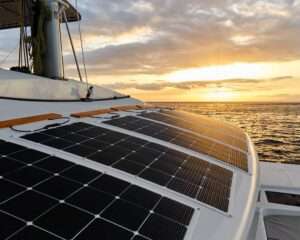Solar panels are becoming more and more popular. Keeping batteries capped up without turning to running the engine is an ongoing problem for yachtsmen.
Boat sun panels invariably is an evident option, not merely in the Med but also around the coasts of the UK because the price of panels has fallen over the years.
But choosing them can be to be a lttle bit of a dark art: after all, how can you possibly predict how much sun you are going to get throughout the season, or how much strength your panel will produce if it may be not exactly in-line with sunlight? Nevertheless provided you acknowledge a statistical method using established directories, then prediction is easier than you think.
Ultimately the only thing we have to know is the conversion efficiency, or, how much sunlight turns into power power. NASA do a trick: each uses multi-layer solar panels where each level responds to a different wavelength therefore the usual 20% approximately is doubled.
Simply how much energy does my boat need?
Step one is to work out your boat’s energy requirements. Just about all you have to do is add up all the power in watt-hours employed by each device on your motorboat, such as the fridge, lighting, computers and so on.
Energy is power accrued as time passes, so if strength is measured in watts, energy is watt-hours. This can be tricky, for example how long will be your fridge operating for? And how about overnight? Exactly how much energy the actual instruments take? Or if your computer?
You can gauge the strength by measuring the Amps and V and multiplying them together to get Watts, but for some reason you need to generate a table like the one below. When you have your energy requirements figured out, I suggest you add a goodly margin for expansion and mistakes – at minimum 10%.
Device Current Duty Wh/day
Fridge 4 0. 5 576
Computer 3 0. 1 86. 4
Lights 2 0. 1 57. six
Fan 0. 5 0. 5 72
Losses 0. 1 0. 1 2. 88
Vitality requirement of Aderyn Glas throughout a day. ‘Current’ is Amps. ‘Duty’ is the portion of the afternoon the (12V) appliance is run up. eg Refrigerator 4A x 12-VOLT x 12hr sama dengan 576Wh
Next, you need to determine how much of this requirement should be met by the sevyloyr fish seeker 360 solar panels. We sail our Moody 33 Aderyn Glas throughout the summer season from our bottom in Preveza, Portugal, so our requirements are essentially those of liveaboard mariners.
We want the panels to be able to provide nearly all of our strength needs and allow us not to have to destroy the peace of a quiet chuck by running the engine simply for charging.
Weekend mariners might be content with a small panel to charge – over the course of a week – the energy used throughout a weekend’s sailing. Having the balance right is important, particularly when you want to set up enough boat sun panels to more or less cover your power requirements.
Varieties of boat sun panel
Leaving apart the exotic new Perovskite panels, there are three types that you might consider – a choice that has not changed in years.
There are shadowy panels (good in shady conditions but large for any given wattage), published panels (manufactured with an inkjet inkjet printer but really low conversion efficiency) and crystalline panels either poly- or mono-crystalline.
What type of boat solar solar panels should I fit?This question is a lttle bit of a red herring : the truth is, the question should be ‘How much space do I have? ’
The academic drive is to make panels that are more eco-friendly, both to make and dispose of, also to reduce the cost per watt.
Nevertheless ironically this has resulted in a far poorer conversion efficiency generation by era, which is not helpful to mariners with a small area available to mount the solar panels.
These panels are printed on a continuous inkjet inkjet printer with the idea that they can effectively be great strip. The problem recover, though, is the existing can build up and finally burn up out the hooking up cables. Furthermore, these are no good for yachts because the conversion efficiency is so low so you’d have to have a battleship so as to have enough area!
So, returning to the first generation: transparent panels come in mono- or polycrystalline species, nevertheless they only differ slightly in cost per watts and efficiency.
Included with the mix is the entire flexibility aspect: flexible panels require a lttle bit of smart manufacture, and this is given to in higher prices.
Several sailors think versatile panels are a solution because they may be mounted on the deck or coachroof or use the bimini but I have not considered them because all those places appear to be to suffer from covering, really which later.
Where should I actually install my motorboat solar panels?
Need to you be just fitting a little -panel to top-up battery packs on a mooring, get a cheap inflexible panel and find places on your boat where you can tilt it to catch the sun’s rays for the majority of the day.
We all do this during the winter in Greece, where we strap on 20W or so of car battery top-up panels, and it helps out all of us. Choose a place that isn’t tinted for the vast majority of the day which technique should last well.
Perform the sums. I actually have heard of men and women whose batteries have been damaged with a regular high strength being applied to an already recharged battery, even through a regulator. Our rule of browse for trickle-charging is a panel power consumption about 10% of the battery’s described amp-hours, but that is a guess.












